SMALL TURBINES: BIG BUSINESS
LARGE GAS TURBINES MAY GET ALL THE GLORY, BUT SMALLER MODELS ARE ACHIEVING GREATER MARKET SHARE AND WIDER APPLICATION
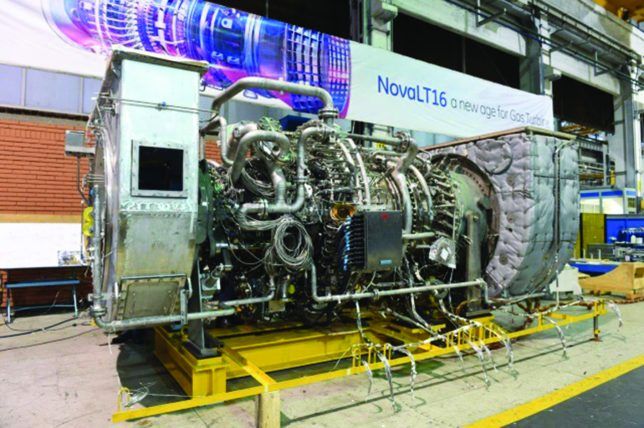
GE NovLT16 gas turbine[/caption]
Drew Robb
Big things always hog the spotlight. The tallest building in the world gains far more press than many more modestly sized, yet stunningly beautiful structures. Heavyweight fighters earn the big headlines while lightweights and middleweights of supreme skill go largely unnoticed by all but the purist. Mighty mountain ranges such as the Himalayas, Andes, Alps and Rockies are lauded while natural wonders such as the Adirondacks, Ozarks and the Scottish Highlands are underappreciated.
It is the same with gas turbines (GTs), and journalists are as much at fault as anyone else. We always give the most ink to the largest models. Since the nineties, the vast majority of coverage has been about the latest and greatest F-, G-, H- and J-class machines. Smaller, more nimble GTs garner a mention here or there, but rarely are they highlighted. Yet they represent a significant portion of ongoing innovation, as well as a major growth engine. Among those in the forefront of this growth are small turbine manufacturers, such as Capstone, GE Oil & Gas, MAN Diesel & Turbo, Siemens, Dresser-Rand (D-R), Kawasaki, Mitsubishi Hitachi Power Systems (MHPS), Pratt & Whitney Power Systems (PWPS), Solar Turbines and Opra.
10% annual growth
“In the past five years the small turbine market has been growing by up to 10% per year despite the oil & gas downturn and the lack of industrial power generation projects,” said Nicola Marcucci, Gas Turbine & Compressor Product Leader at GE Oil & Gas. “This is driven mainly by pipeline and combined heat and power (CHP) segments, regional trends, gas infrastructure development and emissions reduction initiatives.”
Countries without good grid infrastructures and those prone to natural disasters offer am opportunity for micro and mini turbines, said Valentine Moroz, Chief Operating Officer, SoftinWay. He sees a new application for small GTs as range extenders for electric vehicles. “As more players come into the range above 1 MW, the price will go down, and the market will become even more competitive,” he said. To be sure, the downturn in the oil & gas market has depressed the demand for smaller machines, which have been finding growing use at remote drilling sites. As a result, small turbine manufacturers have been forced to adapt to the changing landscape by targeting newer and more developing markets. Capstone specifically has refocused its efforts on the energy efficiency market.
“We are seeing more of a move to steam production using microturbine exhaust and an integrated burner to make steam for manufacturing and food production,” said Jim Crouse, Capstone’s Executive Vice President, Sales and Marketing. “We are also seeing more direct-drying applications, which use microturbine exhaust for various industrial purposes. Finally, the micro-grid market is growing exponentially.”
Demand is increasing for combined cooling, heat and power (CCHP) projects with larger microturbines in the 200 kW to 2 MW range, said Crouse. In Australia and the Pacific Islands, for example, businesses are switching from diesel to propane-fueled CHP/CCHP because of the improvements in fuel security and economics. Given that there is a much smaller natural gas infrastructure in these regions, the availability of propane has made CHP and CCHP projects more feasible. Capstone is currently running tests on a hydrogen-powered microturbine as well as units that can run on synthetic gases.
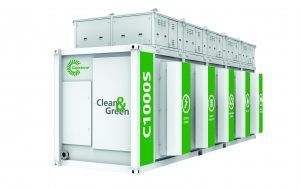
Capstone C1000S microturbine[/caption]
The global demand for heat has stoked the recent surge in CHP. Observers agree that the biggest portion of global energy consumption is for heat ahead of electricity and transport. GTs succeed in delivering high level heat and electricity in industries that have a high heat demand.
GE Oil & Gas expects CHP to grow at 15% or more per year globally. The main drivers are energy efficiency policies, government incentives and GDP. China continues to be among the leaders in GDP growth directly linked to heavy industries, said Marcucci. GTs are likely to be deployed there in a large segment of the CHP market. Korea, too, is experiencing fast economic growth, increasing energy prices and stricter environmental targets. Its chemical and metal industries also have good potential for CHP.
Chinese market
In China, there is a strong drive to reduce the environmental impact of burning coal in relatively inefficient power plants by replacing them with efficient distributed energy gas-fired cogeneration plants, said Nick Muntz, CEO Siemens Distributed Generation business unit. The expectation of these power plants is to reach minimum energy efficiencies of 70%. This can only be realized by employing cogeneration, and when the heat demand is high — GTs typically provide the best fit.
“Most of the global energy consumption today is for heat rather than transport or electricity. Especially in the many industries where this demand exists, GTs bring the maximum benefit,” said Muntz. “Where renewable sources like solar and wind are not economical for intensive heat applications such as process steam, the practical solution is to use gas turbines in cogeneration. This realizes in excess of 85 percent overall efficiency while reducing emissions of CO, NOx, and other pollutants.”
Small GTs are being used in a broader range of applications, especially in terms of waste fuels and complying with environmental regulations. They are also widely used in oil & gas fields because they tend to be more flexible than larger GT’s, said Regine Mowill, Marketing Director, Opra Turbines.
CHP growth
The benefits of CHP are well known in Europe and more mature markets, said Mowill. However, awareness of the environment and energy efficiency is growing in other continents along with policies of distributed generation.
“For process industries in need of high temperature heat for direct drying or steam in addition to power for their operations, CHP provides savings and energy efficiency benefits along with lower emissions, smaller footprint and a quieter package compared to reciprocating engines,” she said.
In North America, MHPS has observed increased interest in cogeneration with small and mid-size turbines due to the low gas price and long-term forecasts of price stability, said Todd Shaw, Director of Industrial Gas Turbine Products at MHPS.
“IPPs (and some unregulated utilities) are seeking to diversify by developing cogeneration projects where steam will be sold to private steam hosts and electric power will be sold to the grid,” said Shaw. “End users such as commercial, chemical, and industrial companies are considering behind-the-fence cogeneration as a means of cutting operating costs, improving reliability, attaining energy efficiency goals, and reducing carbon footprint.”
Reciprocating engines have also upped their game of late, getting bigger as they try to compete with GTs in markets such as CHP, pipeline compression, power generation and distributed generation.
But gas turbines have significantly higher availability, lower maintenance costs, much lower emissions and considerably better fuel flexibility than reciprocating gas engines, said Rainer Kurz, Manager of Systems Analysis at Solar. Customers continue to demand maximum availability and low maintenance, he added.
Specific to power generation applications, Solar has seen a greater variety of renewable fuels gaining in importance, including landfill gas, digester gas and other synthetically produced gases, hydrogen-containing gases as well as liquefied petroleum gas. Orders related to CHP and distributed generation (DG), too, continue to grow.
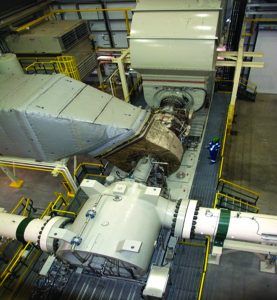
Solar Titan 250 gas turbine[/caption]
As a result of more severe weather and DG, smaller gas turbines are being used for critical care facilities, hospitals, universities and research facilities that cannot afford grid outages and disturbances, said Chris Lyons, Business Development Manager for power generation at Solar. “We are also seeing spiked interest in our gas turbines running in a CHP mode for micro-grid applications.”
Micro-grids are one answer to aging utility grids. Although more market and regulatory reform is required to realize the full benefits, the concept is taking off because micro-grids address grid resiliency, reliability, security, the optimization of fossil and renewable energy, and reduced distribution losses.
A micro-grid is a group of interconnected loads and distributed energy resources that acts as a single, controllable entity to the grid and can operate connected to the grid or in island mode. Core components include renewable sources and conventional sources. One example is the University of California San Diego’s 42 MW micro-grid. Its 12 million square feet of buildings have twice the energy density of traditional commercial buildings. This is achieved using a Solar GT in a micro-grid application.
Modularization
Another trend is the use of mobile power units (MPU) and modular power plants (MPP) that provide low-cost, on-site continuous duty or peaking power. This minimizes on-site civil works, resulting in shorter installation time. Plant connections are limited to fuel lines and medium voltage switchgear, and the units are easy to relocate.
The typical installation for an MPP is a residential, urban or industrial area, as well as utilities for base load, peaking and black start, and observatories and military bases. In a combined cycle power plant (CCPP), such as an airport, industrial zone, factory, or municipality, GT exhaust gases are used to produce high-pressure steam to generate additional power through a steam turbine or low-pressure steam to feed a thermal load.
An example is an installation at the City of Sitka, Alaska. As tourism is critical for Sitka’s economy, loss of electrical power during the tourist season could result in millions in losses. The city’s primary hydraulic power source required maintenance. Backup reciprocating diesel engines could not provide sufficient alternative baseload power during this maintenance period. It deployed a 15 MW Titan 130 MPP to keep the power up and running.
“MPUs are field-proven packages that deliver fast online, cost-effective power for continuous duty, peaking, standby and seasonal or cyclical loads,” said Lyons.
MAN Diesel & Turbo, too, cited standardization and modularization as accelerating trends. The market is asking for machinery packages that are compact, easy to deliver and serving plug-and-play logic for offshore or on land, said Dr. Sven-Hendrik Wiers, Vice President and Head of Engineering Gas Turbines at MAN Diesel & Turbo. This forwards the goal of longer service intervals, in excess of 40,000 equivalent operating hours (EOH). A modular, easy-to-approach design reduces downtime for service intervention,” said Wiers. “Customers expect major overhauls to be carried out within three days.”
Pipeline gas
Marcucci sees promise in the pipeline segment driving more orders for small GTs. In North America, he said, cheap gas and the development of lateral lines (after trunk line development) is driving growth of 5% to 15% per year in terms of expected new miles compared to recent years, especially in the 8 MW to 15 MW range. He added that the pipeline market is expected to grow in Latin America (Peru and Argentina driven by shale gas, as well as Bolivia, Colombia and Brazil).
“Russia is also expanding its grid, building a connection pipeline with China and replacing the installed reciprocating fleet with new GTs,” said Marcucci. “In Asia the pipeline market is also expected to grow.”
Small turbines are finding more and more applications offshore. Various market reports estimate offshore use of GTs in the 5 MW to 25 MW range at 20% of the overall GT market.
Kirk Stalis, Director of Client Services – Gas Turbines, Dresser-Rand business, part of Siemens Power and Gas Division, lamented that the upstream oil & gas market remains challenging. Oil majors have decreased their investments in new projects and must increase plant and machinery productivity while simultaneously complying with increasingly stringent safety, security and environmental issues, he said.
“On the other hand, the use of small gas turbines in midstream applications like pipelines and gas transmission remain relatively strong,” said Stalis. “But competition in the below 5 MW
GT market is increasing from electric motors and reciprocating engines.”
Nevertheless, technological innovation continues at a rapid pace. Capstone, for example, recently launched its Signature Series microturbines, currently sized at 600 kW (C600S), 800 kW (C800S), and 1 MW (C1000S) to provide better durability and corrosion resistance in extreme weather conditions, particularly in high humidity and dusty environments.
These microturbines have been tailored for the energy efficiency market (CHP & CCHP) with an integrated heat recovery module. Improvements to these machines include a relocated engine exhaust stack, redesigned enclosure, two-stage air filtration system and 12-year marine-grade paint.
Opra Turbines latest offering is the OP16-3C. It has the same engine core as the OP16-3A/B and the same power rating of 1.85 MW. But it features a new combustor that burns ultra-low calorific gaseous and liquid fuels such as waste gas, syngas, biogas, coal derived gas, pyrolysis oil and ethanol.
The OP16-3C can run on fuels with heating values as low as 10 MJ/kg and lower under certain conditions. The combustor has been tested on several fuels including pyrolysis oil and a syngas with a heating value of 6 MJ/kg. It can operate in dual-fuel mode with a high-calorific fuel (liquid or gas) as a back-up fuel, and in bi-fuel mode where a supplementary fuel can be used to boost an ultra-lean composition. OP16 series GTs have an all-radial rotor configuration allowing for operation on flare gas and biofuels with higher levels of contaminants. The engines have low emissions combustion, low maintenance and a compact package. “The OP16-3C has enabled Opra to enter the waste-to-energy market as well as cater to the growing demand of alternative fuels within industrial CHP and remote oil & gas fields,” said Mowill.
Solar’s newest gas turbine is the Titan 250, ISO-rated at 30,000 hp (22.4 MW) with 40% efficiency. It has a high power density, improved availability, durability and serviceability, and low emissions. The Titan 250 is available for compressor set, mechanical drive and generator set applications. Solar also supplies a line of centrifugal gas compressors to support the Titan 250. “Over 50 Titan 250s are or will be installed in 15 countries around the world in a variety of oil & gas and power generation applications, including chemical manufacturing, pulp and paper manufacturing, district heating, university cogeneration, gas compression, gas transmission, gas lift and powering government facilities,” said Kurz.
Further, Solar has noticed growing demand for Electric Motor Drives (EMD). The company has developed the Spartan as an integrated EMD to complement its GT generator sets. The Spartan EMD was designed as a standardized compression unit for the onshore oil & gas market. It comes in standardized product configurations, a pre-engineered package design, and an expanded power range drive train. It also has an integrated oil system, a gearbox-driven main, a pre- and post-lube oil pump, component accessibility for servicing, a driven skid design for multiple-driver applications, and a two-piece skid for transportability.
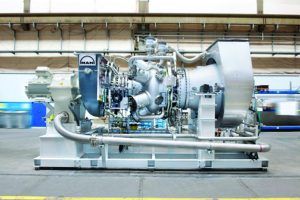
MAN’s MGT series[/caption]
MAN recently introduced the MGT gas turbine series. Starting in the power range of 6 MW, this turbine family will be expanded over time. Designed as single-shaft and twin-shaft turbine, it is applicable for power generation and mechanical drive. MGTs have black start capacity and will also have dual-fuel ability. Four of these GTs are serving a Volkswagen plant in Shanghai in a CHP set-up, reducing carbon emissions of the factory by almost 60,000 tons per year.
GE Oil & Gas, meanwhile, has been investing heavily in the development of the NovaLT family. It serves smaller power ranges for power generation, as well as mechanical drive for both oil & gas and industrial applications. The company launched the 16 MW NovaLT16 in 2014, working with TransCanada Corporation in a collaboration to provide a customized solution for the pipeline sector. It boasts a 37% mechanical efficiency, up to 99% availability and 35,000-hours between maintenance.
GE Oil & Gas extended the family with the NovaLT5. It is an improved version of the GE5 and builds on the technology of the NovaLT16. This 5 MW range machine is available in single-shaft and double-shaft configurations. It has 30.7-31.5% electrical/mechanical efficiency and up to 24,000 hours between maintenance. “The compact design of the NovaLT5 makes it suitable for operations with challenging footprint and height restrictions,” said Marcucci. “The high exhaust temperature also makes it well-suited to Heat Recovery System (HRS) operations.”
The latest addition to the Siemens gas turbine portfolio is the mechanical drive version of the SGT-300. Known as the SGT-300 twin-shaft, it has a gross efficiency of 35.7%, is customizable, has an output of 8.2 MW (11,000 hp), fuel flexibility and 32,000 hours between major overhauls.
Kawasaki’s M7A baseload engine is used in GTs such as the GPB70 and GPB80. The GPB80 is popular in oil & gas applications due to its compact design and low weight. This machine has achieved 15 ppm of NOx. It has an output of about 7.7 MW, and an electrical efficiency of 33.3%.
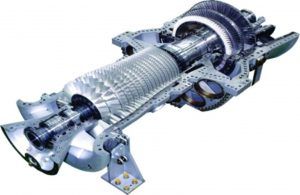
MHPS H-25 gas turbine[/caption]
MHPS’s H-25 consists of a 17-stage axial compressor with a single-shaft, three-stage impulse-type GT that is air cooled and produces 28.1 MW to 42 MW in simple cycle mode (at ISO conditions). Its net efficiency is 37.2% (LHV). It has a GT turndown of 50% and a 22-minute start-up time to full load. The exhaust flow is 244 lb/s and the exhaust temperature is 1,033°F. It can achieve 15 ppm NOx and 9 ppm CO. The H-25 was originally introduced in 1988 and has achieved in excess of 6.3 million actual fleet operating hours. The most recent advancement to the H-25, optimization of the turbine section, has increased its simple cycle output from 35 MW to 42 MW and boosted efficiency.
“The H-25 is a fuel-flexible turbine that is capable of combusting low-grade fuels, natural gas, distillate, liquid propane gas (LPG), and hydrogen-rich fuel in excess of 50% hydrogen content,” said Shaw.
Combustion options include a pre-mix combustor and a DLN combustor comprised of a 10-can reverse-flow design with a multi-cluster configuration. This is a rapid-mix design that is flash-back free, resulting in stable and flash-back free combustion.
The H-25 turbine has served as the development platform for each of the MHPS H-Series turbines, including two-shaft GTs, such as the H-100 and the new 57.4 MW H-50 gas turbine, which has exhaust energy of 320 MM Btu/hr. “The H-50 is suitable for mechanical drive, and cogeneration and combined cycle applications,” said Shaw.
The first H-50 turbine was introduced in 2011 and validated in the advanced humid air turbine (AHAT) pilot plant in Japan, which operated from 2012 to 2014. The second H-50 turbine is scheduled for full load testing later this year.
PWPS provides 30 MW of mobile power via its FT8 MOBILEPAC GT package. It has a small footprint, delivering high power density. It can be transitioned from contract to commissioning within a few weeks.
“We continue to see strong demand for distributed generation based on aeroderivative GTs in developing countries,” said Charles Levey, Senior Vice President of PWPS. “Many of these countries see DG as an answer to electrification, where installation logistics can be challenging.”
“Small and mid-size gas turbines offer a cost-effective and flexible solution for simple cycle, combined cycle, and cogeneration applications ― especially when reliability and availability are considered,” said MHPS’s Shaw.
“Smaller gas turbines are here to stay,” adds Opra’s Mowill, “and likely to be used in further applications within and beyond the current industrial CHP, standby and oil & gas markets as the energy markets transition.”